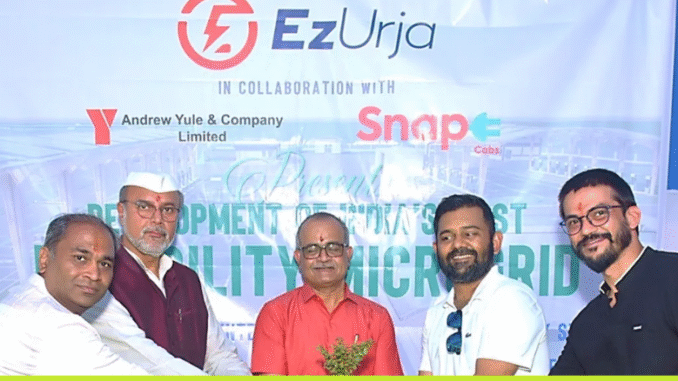
Expansion plans include the development of ten additional charging hubs along the 250-km Kolkata–Asansol highway by 2026. The project also aims to increase the share of renewable energy to 60%. Continuous improvement of AI capabilities will enhance predictive charging and grid management. Furthermore, the model is being positioned for replication in ASEAN and African countries.
Location: Togami, Thakurpukur, Kolkata (repurposed 2-acre site of defunct AYCL plant) Capacity: 6 MW total load Renewable
Share: 40% (2.4 MW from solar and wind)
EV Chargers: 300 units (20% fast chargers up to 120 kWh, 80% slow chargers)
Manufacturing: 80% domestically made in Himachal Pradesh
Timeline: Commissioning by August 2025
Primary User: Snap-E’s 300 electric cabs
Challenge and Context :
Kolkata faces mounting urban pollution with over 4.5 million registered vehicles, creating an urgent need for sustainable transportation solutions. Additionally, India’s commitment to reach net-zero emissions by 2070 requires innovative approaches to energy and mobility. The project also aimed to address the challenge of repurposing underutilized public sector land while building clean energy infrastructure.
Microgrid Architecture :
- Decentralized microgrid combining solar panels, wind turbines, and Battery Energy Storage Systems (BESS)
- Ensures 24/7 operational reliability with 40% reduced reliance on the main grid
- Future-ready design allowing for increased renewable contribution in subsequent phases Smart
Charging Ecosystem :
- AI and IoT-powered Charging Management System (CMS) for real time load balancing
- Predictive maintenance capabilities and dynamic pricing
- Optimized charger availability and energy utilization
Energy Efficiency Strategy :
- Solar generation meets daytime demand with excess stored in BESS for nighttime use
- Grid power serves as backup during peak loads or shortfalls
- Intelligent load management prevents overloading fossil-based infrastructure
| Metric | Kolkata Hub | China’s Largest Hub |
| Chargers | 300 | 650 |
| Energy Source | 40% renewables | Mostly grid-powered |
| Localization | 80% Made in India | Undisclosed |
| Technology | AI microgrid | Standard integration |
While smaller in scale than the Chinese counterpart, EzUrja’s hub distinguishes itself through its sustainability-focused design and innovative approach.
Industrial Heritage Revitalization
- Transforms an underutilized AYCL site into a clean technology center
- Preserves Kolkata’s historical industrial fabric while adding modern purpose
- Demonstrates effective brownfield redevelopment strategy
Local Economic Development
- Creates green jobs through local sourcing and operations
- Strengthens domestic supply chains in renewable energy and EV sectors
- Provides skills development opportunities in emerging technologies
Sustainable Urban Mobility
- Accelerates EV adoption, particularly in commercial transport
- Improves air quality and reduces noise pollution
- Creates model for integrated mobility solutions
Future Roadmap
- Expansion 10 new Kolkata-Asansol charging hubs by 2026.
- Renewable Growth 60% renewable energy share by 2026.
- Technology Enhancement Ongoing AI upgrades for smart charging & grid.
- Global Replication Position model for ASEAN & Africa by 2026/2027
STRENGTHS
- 40% Renewable Power
- High Localization
- AI‑Driven Microgrid
- Brownfield Revitalization
WEAKNESSES
- High CapEx Grid
- Integration Complexity Limited
- Initial Demand
THREATS
- Incentive Uncertainty
- Larger Competitors
- Tech Evolution
OPPORTUNITIES
- Network Expansion
- Policy Incentives
- Export Potential
The EzUrja-AYCL solar-powered EV charging hub represents a significant advancement in India’s transition to clean mobility. By combining renewable energy, smart grid technology, and domestic manufacturing, the project offers a replicable model that balances sustainability with economic development. This case study demonstrates how public-private partnerships and innovative microgrid solutions can create scalable, environmentally beneficial transportation infrastructure for developing economies.
Mathematical Proof of Effectiveness:
1. Renewable Energy Generation
Annual Renewable Energy = Capacity (MW) × Renewable Fraction × Hours per Day × Days per year
= 6 MW × 0.4 × 24 hours × 365 days = 21,024 MWh/year
2. CO₂ Emissions Avoided
Using India’s official grid emission factor for FY 2023-24: CO₂ Emissions Avoided = Annual Renewable Energy (MWh) × Grid Emission Factor
= 21,024 MWh × 0.727 tonnes CO₂/MWh = 15,284.45 tonnes
Note: The grid emission factor of 0.727 tCO₂/MWh is sourced from the Central Electricity Authority’s CO₂ Baseline Database for the Indian Power Sector for FY 2023-24.
3. Equivalent Tree Sequestration
A mature tree sequesters approximately 22 kg (0.022 tonnes) of CO₂ per year. Therefore: Number of Trees Required = Emissions Avoided / Absorption per tree
= 15,284.45 / 0.022 = 694,748 trees
The annual CO₂ reduction from this hub equals the environmental benefit of nearly 695,000 mature trees.
Public-Private Collaboration
- Successful partnership between public sector entity (AYCL) and private innovation (EzUrja)
- Snap-E’s involvement ensures immediate infrastructure utilization
- This triple alliance model creates commercial viability while advancing technological innovation
Policy Alignment
- Supports FAME-II scheme objectives and India’s 2070 net-zero target
- Contributes to “Make in India” initiative with 80% local manufacturing
- Promotes green technology sector growth and job creation



